Where to go, where to stay: the traditional and the modern
By Lucy Komisar
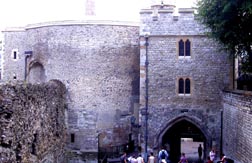
London, glorious London. I know we Americans (or some of our ancestors) fought them in the 1700s, but they are still our best friends, aren‘t they? For theater, art, and experience, London is like leaving home to visit cousins. (Leaving the colonies to cross the Pond, as the Brits would say.) What I find wonderful about London is the easy fusion of the traditional and the modern. Traditional, by the way, sometimes goes back a thousand years!
Start with the traditional. To get a good grasp of the gory Royals, there‘s no place better than the Tower of London, founded by William the Conqueror in 1066-7 and enlarged and changed by royal houses that followed. The best way to see it is with a guided tour by one of the Beefeaters, those fellows who look like the picture on the gin bottle and take you around the Tower grounds explaining, with delicious, malicious enjoyment, the dreadful incarceration and murder of Anne Boleyn, two child princes, and other enemies of whoever was running the state. It‘s a bit like having your own personal version of a Shakespeare play.
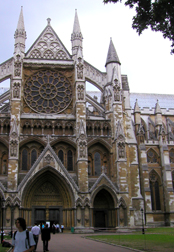
Be sure to get there by the last tour at 3:30 pm; I‘ve done it both ways, and I‘ve learned that you miss too much wandering around without a guide. You can also see the crown jewels at the Tower. It gives you an idea of what the royals were fighting for! And what the republican Oliver Cromwell was fighting against.
Westminster Abbey, founded in the 10th century, is also fascinating to visit, because it shows the transition between old values and new. There are the tombs of the royals going back centuries, including, generously, both Queen Elizabeth I and the cousin she had murdered, Mary Queen of Scots! The tombs are topped with wonderful prone sculptures of the deceased, and, still not distant, sometimes their servants! But there‘s also an entire section with the memorial stones for theater people – the 18th century actor, playwright and theater manager David Garrick, for example, and Laurence Olivier. And another section for poets. A young American tourist mused, “Hmm, Robert Browning, I think he‘s famous.”
In historic buildings, give me old. In art, give me new. London is a city that loves art, and the best places to view art seem to be along the Thames River. The new Tate Modern is the trendiest city museum, set south of the river a short walk east of the National Theatre complex. I saw the stunning Frida Kahlo exhibit, which was jammed with aficionados of that cult-figure Mexican painter. The Chelsea Tate still has the Turners, but the new building on the South Bank is the place to go! And do so early when there‘s a blockbuster show. (You can take a boat between the Tates.)
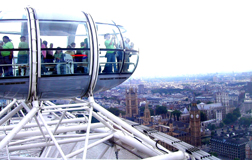
Few of those art-lovers appeared to know about the Saatchi Gallery, also on the south bank of the Thames. If Tate is modern, Saatchi is avant garde. I must confess that much of it left me cold, except for an extraordinary permanent installation by Richard Wilson. It is a triumph of “trompe l‘oeil,” a room filed waist-high with recycled engine oil, which you enter on a narrow walkway at mid-height. Its mirrored surface reflects the buildings seen through the windows. Hard to explain. You have to see it!
Just outside the Saatchi Gallery is the London Eye, the huge Ferris wheel sponsored by British Airways for the London Millennium. The Millennium has disappeared, but the London Eye turned out to be enormously successful. The enclosed oval compartments – a bit like ski-lifts – bring you high in the sky over the Thames in perfect position to see Big Ben, the Houses of Parliament, Buckingham Palace and more. It takes about half an hour to make the full turn, and everyone moves up to the strategic place from where to snap the best photo they will ever take of those famous landmarks.
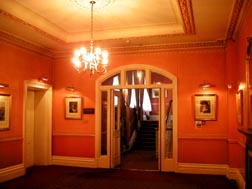
So here we go from the traditional to the new in hotels!
Within walking and spiritual distance of Buckingham Palace, the Thistle Victoria has halls of pastel blue and deep pink hung with etchings and watercolor views of the era of its Victorian namesake – the Albert Memorial, the Parliament, the aristocrats of the social whirl. There are marble pillars, crystal chandeliers and lush carpets in deep rose or royal blue. If you let your mind wander, you can imagine entering the elegant lobby and climbing the central staircase to a ballroom. This is Old England!
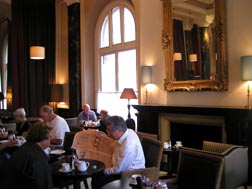
These days, of course, you‘re more likely to come back from a day of touring and relax on plush arm chairs and couches in the Thistle Victoria dining room. Or go to the club bar, with plaques of British and American sports teams; the bar is open only for hotel guests after hours. Most of those guests will be English, not foreign tourists, as Thistle hotels are considered by Brits as “home.” The rooms have the comfy feeling of Old England.
With a perfect location next to the Victoria rail terminal, there‘s even an entrance to the Thistle right in the station.
The Victoria tube station and bus depot are adjacent, so you can travel easily around the city and also get the bus to and from Heathrow and the express train to Gatwick Airport. (You can use your BritRail pass for the Gatwick train.)
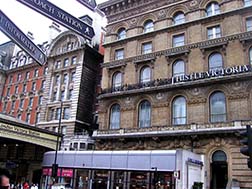
I discovered another advantage: food and wine stores, including Sainsbury‘s and Marks & Spencer, as well as fast-food places in the train station, are open till midnight. I only had to cross the street to the Victoria Palace to see the smash hit musical, “Billy Elliot,” about a young boy from a coal mining town who wants to be a dancer.
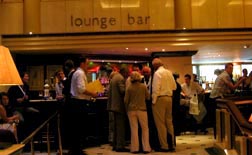
So, what does the New England look like? It‘s a Hilton, of course. Arriving at the Hilton Metropole, I was greeted by a party-in-progress in the large lobby bar – a convention of charity fundraisers. Some of them took their wine glasses over to the sports bar. Meeting friends, I sought “Eastern” calm at the “Nippon Tuk,” (ok, a bad pun!), the Japanese-Thai 24th-floor bar, with comfortable booths affording a stunning, panoramic view of the city. Cuisine is a Hilton strongpoint. Breakfast was a feast – my favorites were fresh papaya, flaky croissants, and made-to-order omelets.
With a honeycomb look from the outside, the Metropole has large picture windows on rooms that are spacious and modern. The large desks are perfect for spreading out maps and brochures as well as for a business traveler‘s working documents. Wi-fi hotspots are all over the place. The large lobby has tables and chairs where you can meet and greet guests. I sat there with my computer plugged into an outlet. Typically client friendly, Hilton even has a lobby cash machine.
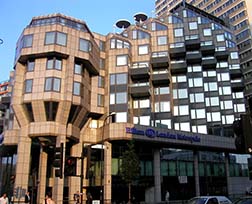
The Hilton Metropole, located in West London between Hyde Park and Regent‘s Park, is just a block from the tube station. It‘s also close to Paddington Station, rail terminal for the 15-minute train to and from Heathrow. When I arrived at Paddington for the short hop to the airport, I discovered ticket machines right at the station entrance. Bright floor markings lead to the Heathrow-bound platform. If you have a BritRail pass, as I did, the taxi-to-train change is even quicker. That fast airport train, which never gets stuck in traffic, allowed me to make a 9 am flight without rising in the pre-dawn.
If you go:
Thistle Victoria
Buckingham Palace Road
London SW1W 0SJ
Tel 44 (0)870 333 9120
Fax 44 (0)870 333 9220
Vi******@********co.uk
Hilton Metropole
225 Edgware Road
London W2 IJU
Tel 44 (0)20 7402 4141
Fax 44 (0)20 7724 8866
800 445-867
cb***********@****on.com
Tower of London
Tel: 44 (0)870 756 6060
Westminster Abbey
For opening times, tour times and reservations.
Tel: 44 (0)20 7654 4900
Fax: 44 (0)20 7654 4894
in**@***************ey.org
Tate Museum
Bankside SE1 9TG
44 (0)20 7887-8000
44 (0)20 7887 8008 recorded information
44 (0)20 7222-5152
Saachi Gallery
County Hall
South Bank
recorded information: 44 (0)20 7823 2363
enquiries/bookings: 44 (0)20 7928 81
London Eye
44 (0)870 5000 600 (8.30am-6.30pm).
Book online to avoid the lines.
BritRail
I arrived in London after stops in Cardiff, Bath, Colchester (Essex) and Cambridge, and made good use of a 4-day Britrail pass good all over the UK. Available only to non-residents, they must be purchased before you arrive and afford 4 days of travel in two months for $265. Eight days costs $385, and 15 days is $585. Prices vary for youths, seniors and first class. For information, BritRail or 866-BritRail.

